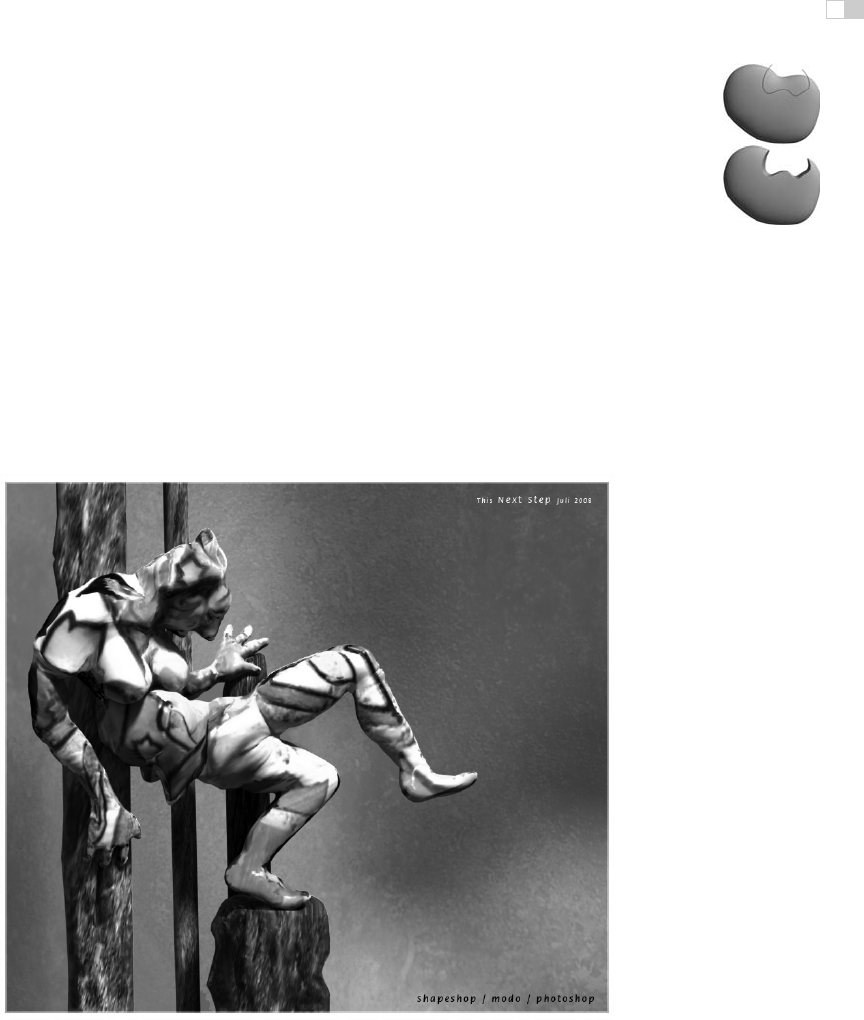
i
i
i
i
i
i
i
i
410 16. Implicit Modeling
Figure 16.28. “Spiral Stairs.” A complex BlobTree implicit model created in Erwin DeGroot’s
BlobTree.net system. (See also Plate VI.)
• union: max(f(L(N),M),f(R(N),M));
• intersection: min(f(L(N),M),f(R(N),M));
• difference: min(f (L(N),M), −f(R(N),M)).
A complex BlobTree model showing many of the features that have been in-
tegrated is shown in Figure 16.28.
16.9 Interactive Implicit Modeling Systems
Early sketch-based modeling systems, such as Teddy (Igarashi et al., 1999), used
a few drawn strokes from the user to infer a polygonal model in 3-space. With
better hardware and improved algorithms, sketch-based implicit modeling sys-
tems are now possible. Shapeshop uses implicit sweep surfaces to manufacture
Figure 16.29. Outlines
are inflated.
Image cour-
tesy Erwin DeGroot
.
3D strokes from 2D user strokes and also preserves the hierarchy of the BlobTree
unlike the early systems that produced homogeneous meshes (Schmidt, Wyvill,
Sousa, & Jorge, 2005). This enables a user to produce complex models of ar-
bitrary topology from a few simple strokes. The margin figures show a closed

i
i
i
i
i
i
i
i
16.9. Interactive Implicit Modeling Systems 411
drawn stroke (Figure 16.29) inflated into a an implicit sweep and a second sweep
(Figure 16.30) that has a smaller sweep object subtracted using CSG.
Figure 16.30. BlobTree
operations can be applied,
e.g., CSG difference.
Im-
age courtesy Erwin DeG-
root
.
One of the improvements that made this possible is a caching system that uses
a fixed 3D grid of implicit values at each node of the BlobTree representing the
values found by traversing the tree below the node (Schmidt, Wyvill, & Galin,
2005). If the value of some point p is required at node N, a value may be returned
without traversing the tree below N, provided that part of the tree is unaltered.
Instead, an interpolation scheme (see Chapter 28) is used to find a value for p.This
scheme speeds up traversal for complex BlobTrees and is one factor in enabling a
system to run at interactive rates.
The next generation of implicit modeling systems will exploit hardware
and software advances to be able to handle more and more complex hierarchical
models interactively. A more complex Shapeshop example is shown in Fig-
ure 16.31.
Figure 16.31. “The Next Step.” A complex BlobTree implicit model created interactively in
Ryan Schmidt’s Shapeshop by artist, Corien Clapwijk (Andusan). (See also Plate VII.)
i
i
i
i
i
i
i
i
412 16. Implicit Modeling
Exercises
1. In an implicit surface modeling system the fall-off filter function is defined
as
f(r)=
0,r>R,
1 − r/R, otherwise,
where R is a constant. A point primitive placed at (−1, 0) and another
at (1, 0) are rendered to show the f =0.5 iso-surface. The value R,the
distance where the potential due to the point falls to zero in both cases, is
1.5.
Calculate the potential at the point (0, 0) and at +0.5 intervals until the
point (2.5, 0).Sketchthe0.5 contour and the contour at which the field
falls to zero.
2. Why are the ambiguous cases in the polygonization algorithm considered
to be a sampling problem?
3. Calculate the error involved in using linear interpolation to estimate the
intersection of an implicit surface and a cubic voxel.
4. Design an implicit primitive function using the skeleton of your choice. The
function must take as input a point and return an implicit value and also the
gradient at that point.
..................Content has been hidden....................
You can't read the all page of ebook, please click here login for view all page.
